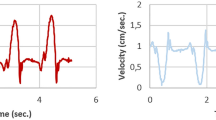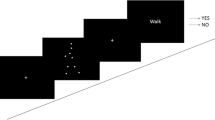Summary
It is suggested that visual-imaginal encoding of actions, i.e., imagining seeing somebody else performing a described action, should be distinguished from motor-imaginal encoding, i.e., imagining how one performs the action oneself. While both kinds of encoding should provide good item-specific information, only visual-imaginal encoding should also lead to good relational encoding of word pairs. In three experiments in which subjects had to learn verb pairs, we obtained supporting data for this assumption. Although CR performance was equal to FR performance under visual-imaginal encoding, under motorimaginal encoding CR performance was worse than FR performance. In principle, this finding parallels results obtained with imagined noun pairs and with performed verb pairs.
Similar content being viewed by others
References
Anderson, J. R. (1983). The architecture of cognition. Cambridge, Mass.: Harvard University Press.
Begg, I. (1973). Imagery and integration in the recall of words. Canadian Journal of Psychology, 27, 159–167.
Begg, I. (1978). Imagery and organization in memory: Instructional effects. Memory & Cognition, 6, 174–183.
Bower, G. H. (1970). Organizational factors in memory. Cognitive Psychology, 1, 18–46.
Bower, G. H. (1972). Mental imagery and associative learning. In L. W. Gregg (Ed.), Cognition in learning and memory. New York: Wiley.
Denis, M. (1989). Image et cognition. Paris: Presses Universitaires de France.
Denis, M., Chevalier, N., & Eloi, S. (1989). Imagerie et répétition mentale dans l'acquisition d'habiletés motrices. In A. Vom Hofe (Ed.), Tâches, traitement de l'information et comportements dans les activités physiques et sportives. Issyles-Moulineaux: EPA. (in press)
Engelkamp, J. (1986a). Nouns and verbs in paired associate learning: Instructional effects. Psychological Research, 48, 153–159.
Engelkamp, J. (1986b). Differences between imaginal and motor encoding. In F. Klix & H. Hagendorf (Eds.), Human memory and cognitive capabilities. Amsterdam: North-Holland.
Engelkamp, J. (1987). Modalitätsspezifische Gedächtnissysteme im Kontext sprachlicher Informationsverarbeitung. Zeitschrift für Psychologie, 195, 1–28.
Engelkamp, J. (1988). Modality-specific encoding and word class in verbal learning. In M. Gruneberg, P. Morris, & R. N. Sykes (Eds.), Practical aspects of memory. Chichester: Wiley.
Engelkamp, J., & Sieloff, U. (1985). Individual differences in motor imagery ability and recall of action phrases. Archiv für Psychologie, 137, 241–253.
Engelkamp, J., & Zimmer, H. D. (1983). Zum Einfluss von Wahrnehmen und Tun auf das Behalten von Verb-Objekt-Phrasen. Sprache & Kognition, 2, 117–127.
Engelkamp, J., & Zimmer, H. D. (1985). Motor programs and their relation to semantic memory. German Journal of Psychology, 9, 239–254.
Engelkamp, J., & Zimmer, H. D. (1989). Imagery and action: Differential encoding of verbs and nouns. In P. J. Hampson, D. F. Marks, & J. Richardson (Eds.), Imagery: current developments. London: Routledge & Kegan Paul.
Helstrup, T. (1987). One, two, or three memories? A problemsolving approach to memory for performed acts. Acta Psychologica, 66, 37–68.
Helstrup, T. (1989). Memory for performed and imaged noun pairs and verb pairs. Psychological Research, 50, in press.
Heuer, H. (1985). Mental practice of motor skills. Report No. 44 of the Research Group of Perception and Action. Bielefeld: Center of Interdisciplinary Research (ZIF), Bielefeld.
Hishman, E., & Bjork, R. A. (1988). The generation effects: Support for a two factor theory. Journal of Experimental Psychology: Learning, Memory, and Cognition, 14, 484–495.
Jacobson, E. (1932). Electrophysiology of mental activities. American Journal of Psychology, 44, 677–694.
Jones, G. (1984). Optimal use of imagery in learning and performance. In H. Reader (Ed.), Sportpsychology international. Cologne: bps-Verlag.
Marks, D. F. (1973). Visual imagery differences in the recall of pictures. British Journal of Psychology, 64, 17–24.
Marks, D. F. (1977). Imagery and consciousness: A theoretical review from an individual differences perspective. Journal of Mental Imagery, 1, 275–290.
Paivio, A. (1982). Individual differences in coding processes. In F. Klix, J. Hoffmann, & E. van der Meer (Eds.), Cognitive research in psychology. Amsterdam: North-Holland.
Puni, A. Z. (1958). Über die Trainingswirkung der Bewegungsvorstellung (Dtsch.). Theoretische Praxis der Körperkunde, 7, 1067–1075. Nachgedruckt unter dem Titel “Bewegungsvorstellung und Training” in: Sport im Sozialismus — Beiträge zur Theorie der Körpererziehung. Berlin (DDR): Sportverlag 1959.
Richardson, J. T. E. (1978). Mental imagery and memory: Coding ability or coding preference? Journal of Mental Imagery, 2, 101–116.
Roland, P. E., Larsen, B., Lassen, N. A., & Skinhoj, E. (1980). Supplementary motor area and other cortical areas in organization of voluntary movements in man. Journal of Neurophysiology, 43, 118–136.
Sheehan, P. W. (1967a). A shortened form of Betts' Questionnaire Upon Mental Imagery. Journal of Clinical Psychology, 23, 386–398.
Sheehan, P. W. (1967b). Reliability of a short test of imagery. Perceptual and Motor Skills, 25, 747.
Thomas, A. (1978). Einführung in die Sportpsychologie. Göttingen: Hogrefe.
Ulich, E. (1967a). Some experiments on the function of mental training in the acquisition of motor skills. Ergonomics, 10, 411–419.
Ulich, E. (1967b). Über verschiedene Methoden des Lernens sensumotorischer Fertigkeiten. Arbeitswissenschaft, 76, 48–50.
Volpert, W. (1981). Sensumotorisches Lernen. Frankfurt am Main: Fachbuchhandlung für Psychologie.
White, K. D., & Ashton, R. (1977). Visual imagery control: One dimension or four? Journal of Mental Imagery, 1, 245–252.
White, K. D., Ashton, R., & Lewis, S. (1979). Learning a complex skill: Effects of mental practice, physical practice and imagery ability. International Journal of Sport Psychology, 10 (2).
Wippich, W. (1980). Bildhaftigkeit und Organisation. Darmstadt: Steinkopff.
Zimmer, H. D. (1984). Enkodierung, Rekodierung, Retrieval und die Aktivation motorischer Programme. Arbeiten der Fachrichtung Psychologie Nr. 91. Saarbrücken: Universität des Saarlandes.
Zimmer, H. D. (1987). Argumente für ein motorisches Gedächtnissystem. In J. Engelkamp, K. Lorenz, & B. Sandig (Eds.), Wissensrepräsentation und Wissensaustausch. St. Ingbert: Röhrig.
Zimmer, H. D. (1989). Selektive Störbarkeit relationaler Information in PAL-Paradigma. Schweiz. Zeitschrift für Psychologie (in press)
Zimmer, H. D., & Engelkamp, J. (1989). Does modality-specific encoding enhance relational information? Psychological Research, (in press).
Author information
Authors and Affiliations
Additional information
The research reported here was supported by a grant from the Deutsche Forschungsgemeinschaft to J. Engelkamp and Hubert D. Zimmer. The paper was prepared during a stay of these authors at the Centre d'Études de Psychologie Cognitive, enabled by a grant of PROCOPE 311 pro
Rights and permissions
About this article
Cite this article
Engelkamp, J., Zimmer, H.D. & Denis, M. Paired associate learning of action verbs with visual-or motor-imaginal encoding instructions. Psychol. Res 50, 257–263 (1989). https://doi.org/10.1007/BF00309262
Received:
Issue Date:
DOI: https://doi.org/10.1007/BF00309262




